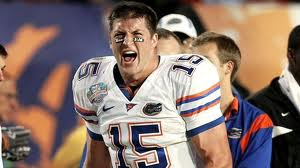 I’m always looking for some angle that allows me to marry my love of sports with some at least tangentially-related topic from marketing research. This one I think is actually pretty good. Tebow is a media lodestone right now, and segmentation… well, that’s about my favorite topic (outside of sports and food).
I’m always looking for some angle that allows me to marry my love of sports with some at least tangentially-related topic from marketing research. This one I think is actually pretty good. Tebow is a media lodestone right now, and segmentation… well, that’s about my favorite topic (outside of sports and food).
Without further ado…
There is no shortage of skeptics when it comes to either segmentation, or Tebow. Segmentation studies (not mine) are notorious for providing “interesting” but ultimately useless information. Similarly, Tebow has been dissected and criticized by a myriad of experts, including draft gurus Mel Kiper Junior and Todd McShay.
Neither segmentation nor Tebow are about perfection, but about increasing your odds of winning. Given each individual is unique, the only “perfect” segmentation scheme would have one segment per member of the population. So given perfection is impossible, segmentation becomes an exercise in finding a scheme that dramatically increases your chances of “winning” with individuals through differentiated treatment of the groups (e.g., better products and/or marketing messaging and/or targeting). Similarly, Tebow is far from anyone’s epitome of NFL QB perfection. He’s too short, too stocky, and has lousy mechanics. But he’s a proven winner at the NCAA level, and Denver is 6-21 in Kyle Orton’s last 27 starts.
Both Segmentation and Tebow are about leadership and both can change cultures. Strategic segmentation (when done well) can change organizational cultures by defining which segment(s) a business will “live for.” Better understanding your most important segments of customers and prospects helps define what their North Star is, and can result in dramatic changes to everything from product offerings to how your company is organized. It provides a foundational roadmap for where a business needs to go and why. Similarly, Tebow’s greatest strength is his leadership. His quiet and humble confidence is infectious, as witnessed by how universally (with the notable exception of Brandon Lloyd) both sides of the ball rallied around him before and during last Sunday’s game. In the matter of a week, the Broncos went from a team mired in failure to one with a lot of hope. (Yes, I know, we can thank the Dolphins for that too… but cut me some slack here).
Segmentation and Tebow will both take time and dedication to succeed. Segmentation is foundational, and therefore should not be rushed. It takes time to create the instrument that will allow you to uncover and profile the most actionable segments, and time and effort analyze and evaluate the data too. Similarly, Tebow is a work in progress. For 50+ minutes on Sunday, Tebow looked like he had no business playing QB in the NFL. He was woefully inaccurate, and he was uncomfortable reading the defense. It’s possible that his mechanics will never improve, but Tebow will never stop trying to get better.
Segmentation and Tebow are both partially defined by faith and abstinence. Unlike some market research studies where the results can be very clear and prescriptive (e.g., the most profitable product configuration and price from a conjoint-based study, or choosing the right product positioning from a monadic concept test), segmentation is usually the beginning of a journey rather than the end. Action either requires more research on the most important segments, or some leap of faith to decide to (for instance) create new messaging based on their motivational profile. It also requires abstinence in that segmentation is almost always about who you don’t (proactively) focus on as who you do focus on. No company can be all things to all people (or businesses), and the decision to walk away from some audiences is hard. Like Tim (who credits his faith for the strength to resist temptations that have kept others in his position from reaching their potential)—it’s important to focus on your goal, and avoid distractions that might sidetrack you along the way.
In a nutshell, both strategic segmentation and Tim Tebow are potential sea-changing initiatives that can have major impacts on the organizations that undertake them. Risk free? Absolutely not. But with the right time, effort and coaching they can both pay off big time.
Posted by Brant Cruz. Brant is CMB’s self-proclaimed Segmentation Prophet. And, he’ll be rooting hard for Tebow to succeed (except when he plays either of Brant’s fantasy football teams or his beloved Chicago Bears).


 Nearly a year ago, my friend and long-time client Chris Frank (formerly of Microsoft, now Vice President, Global Marketplace Insights at American Express) told me he’d been approached to write a book. Several good-natured digs and a decent steak later, I learned that Chris was serious. By the end of the meal I had been sworn to secrecy. Over the course of the last 10 months I’ve gotten a sneak peek at the title (
Nearly a year ago, my friend and long-time client Chris Frank (formerly of Microsoft, now Vice President, Global Marketplace Insights at American Express) told me he’d been approached to write a book. Several good-natured digs and a decent steak later, I learned that Chris was serious. By the end of the meal I had been sworn to secrecy. Over the course of the last 10 months I’ve gotten a sneak peek at the title (